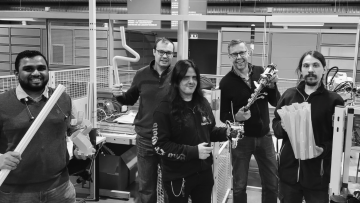Bengs & Cordero: “Technobothnia has a new robotic additive manufacturing environment”

The column has been published in Vaasa Insider on December 30th 2021.
The writers Dennis Bengs (Novia UAS) and Miguel Zamora Cordero (University of Vaasa) are part of a team of researchers and students working in the TB-RAM Center of Excellence project (TB-RAM CoE).
A new type of robotic additive manufacturing environment has been created over at Technobothnia laboratories. The TB-RAM CoE project was a collaboration between Novia UAS, University of Vaasa and VAMK to create a state-of-the-art demonstration environment to aid in the development of additive manufacturing competences in local companies and for university staff and students.
Why robots?
In additive manufacturing, commonly known as 3D printing, real objects are created from digital data. Objects are built layer by layer from plastics, metals, or composites. 3D printing has exploded in popularity over the last couple of decades with 3D printers being available in universities, companies and even in many homes.
Robotic additive manufacturing (RAM) is an extension of regular 3D printing in which a material extruder is attached to a robot arm. RAM leverages the power of robotics with the power of 3D printing, creating brand new possibilities and innovations such as freeform and non-planar printing.
An inherit limitation of regular 3D printers is the size of their frame. The size of created objects cannot be larger than the printer itself as the object needs to fit inside the frame. With a robot mounted printer, the maximum size of the object depends on the reach of the robot arm.
At Technobothnia, the RAM platform is currently the largest printer by volume with objects reaching a size of about 60-70 centimeters, but this is not a hard limitation.
The core of the platform
At its core, the RAM platform is made up from several interconnected components developed by different work groups. Among these components are
- two different types of material extruders, which can be mounted on an IRB-1200 90/5 robot arm from ABB;
- a very large-scale heated build platform;
- several sophisticated software systems developed in-house;
- model slicing profiles; and even
- a parametric freeform slicer.
- State-of-the-art: Freeform printing
- Conventionally, additive manufacturing is done by putting down many consecutive layers of material starting from the bottom of the object and working upwards. Freeform printing turns this idea on its head, allowing objects to be created facing any direction and from any angle (even upside down).
Objects which would otherwise require a lot of disposable support material can with freeform printing be created entirely without any support at all. In addition, freeform printing can be used to create very smooth and sharp edges such as those found on airfoils.
Local services
The RAM platform is available for local companies, university students and staff. Visit our website or contact us at Technobothnia to learn more about the provided services, including in-person demonstrations, prototyping and cooperation opportunities or if you just have questions regarding robotic additive manufacturing and how it can benefit your company.
The TB-RAM Center of Excellence project was made possible through funding from the European Regional Development Fund (ERDF).